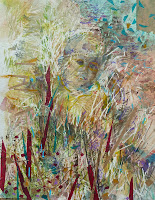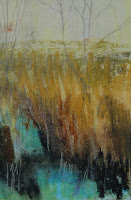My series began with a small oil painting, Out of Focus.It was really a bit of fun, a little release before the serious work of my final project. In reality I learnt that everything that I had been looking at had been simmering away, waiting for an unselfconscious moment. The painting really just 'came out'.
I referred back to some of the research/sketchbook work from the 'scattered images' project in the 'Your Own portfolio" course. I had been intrigued by randomness and control, so I started scattering and glueing small strips of paper over the surface of the canvas. This felt like the random pattern of harvested crops or of the grass verges of the fields and created a lively texture. I then decided to paint in a very loose way with a pallet knife over the surface. I began covering everything with black, then simply worked in a horizon and a field.
Since a recent visit to the Gerhard Richter exhibition I have been interested in the colour and qualities of grey. I have been doing a lot of research into black, but hadn't really considered how important grey could be in your pallete. In this painting I felt inspired to use small negative shapes in grey to bring definition and rhythm. Using grey made the other colours seem to have more importance. Grey is softer, more subtle than black; more subdued, less intrusive or attention seeking than white. I t seems a perfect foil for any colour. I like the way the small grey shapes tend to disappear or recede beyond the fabric of the painting.
In the centre of the painting is a smudge, an area our of focus. This began as an area that I was not quite happy with until I realised that the blurred area helped the eye to work it's way around the painting. I think there a many analogies/comments one could make here about how we 'look' at the landscape and what we value or 'see' there.
The horizon has a slight industrial feel, a reference to the meeting of nature and manufacture which typifies the fens as much as it's flat fields and big skies.
My next work, In the Groove, began as a patchwork of fields using different paper and textures. I was trying to work in a figure of a child hanging onto a pole but was frustrated with the way things were going. It all seemed too direct and contrived. I had so enjoyed the freedom with which I had painted Out Of Focus, that I decided to try to be freer and more spontaneous in my work. I referred back to some of my sketches and decided to focus in on a small area of a little oil pastel of a drain at Oxburgh. I again added some snips of paper and this time included some sand for texture.
Although the original image is almost totally obscured (I can just make out a hand and face in the top right of the painting, and a foot on the top left) It doesn't seem so important. When you look at the painting you will begin to see figures in the shadows. This is how I would like the influence of mankind to be expressed in these paintings, kind of 'behind the scenes'. In reality nature is the dominant feature in the Fen landscape. Man only manipulates it, a kind of puppet master, we see the Work but not the Master.

My third painting, Agneiska,was a rework of a painting I had begun in the summer, of the children at school. When I decided to change the topic of my project the painting was abandoned. Since I had begun to think about incorporating figures in a submerged type of way it seemed appropriate to resurrect the painting. Agneiska is submerged by the landscape, only her face, with an expression of determination and struggle remain( she was trying to pull herself up onto a climbing frame). The tension and struggle is still expressed in the painting via the strong diagonals, and strong contrasts in colour.
I had taken photographs of the land, literally. I held my camera parallel to the ground, zoomed in and snapped away. It was interesting to see the relationship between the arial photos and these zoomed in photos - lots of intersecting!

I decided to use one of these photos as the basis for this painting. I used my scattered strips again, then built up the form. Firstly with a pallete knife and then with a brush. I have also used a pencil. There is a very fluid feel to this painting. The Fens are generally quite damp underfoot. The grasses are like a wave traversing the canvas. The textures expressing the soil on the top left appear like a flock of birds taking flight, while on the right the grass strips are like an army of cranes, or search lights from a prison. Once more there are shadowy figures to be found alluding to man's role in the landscape.























